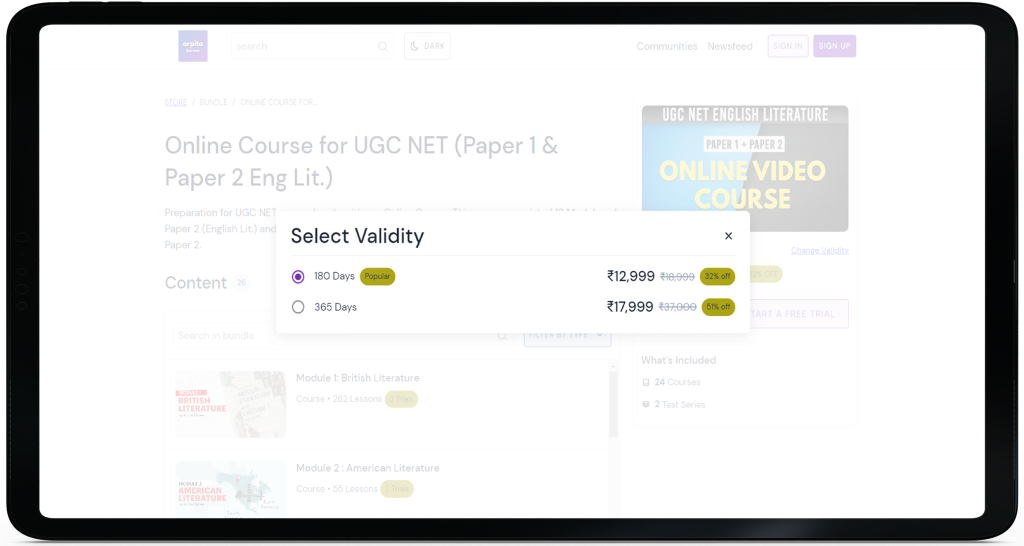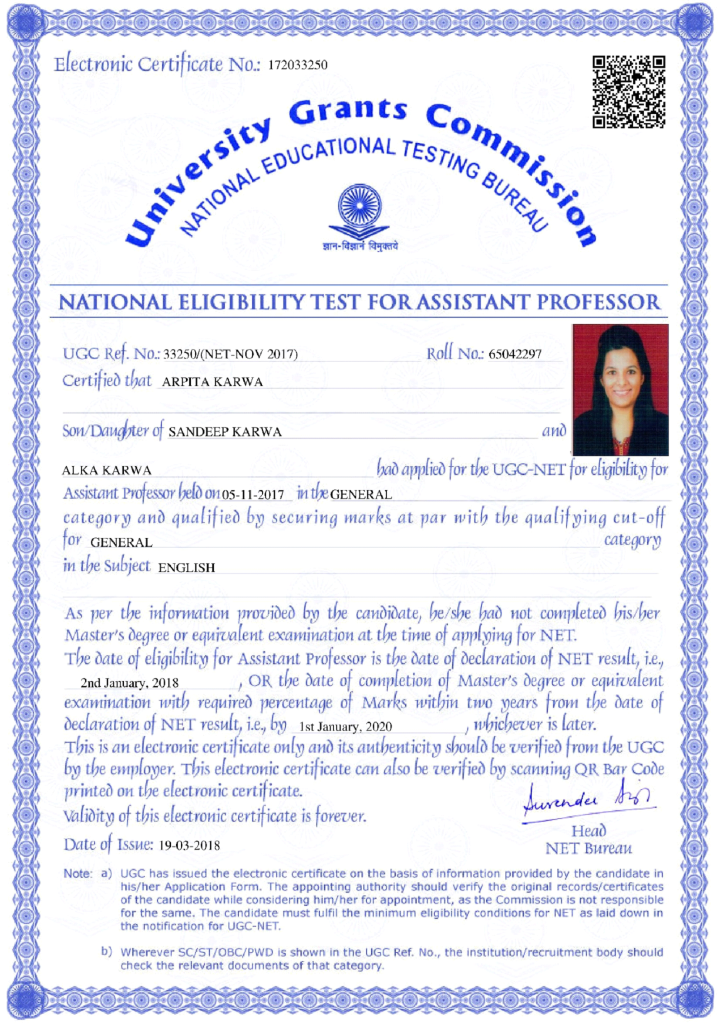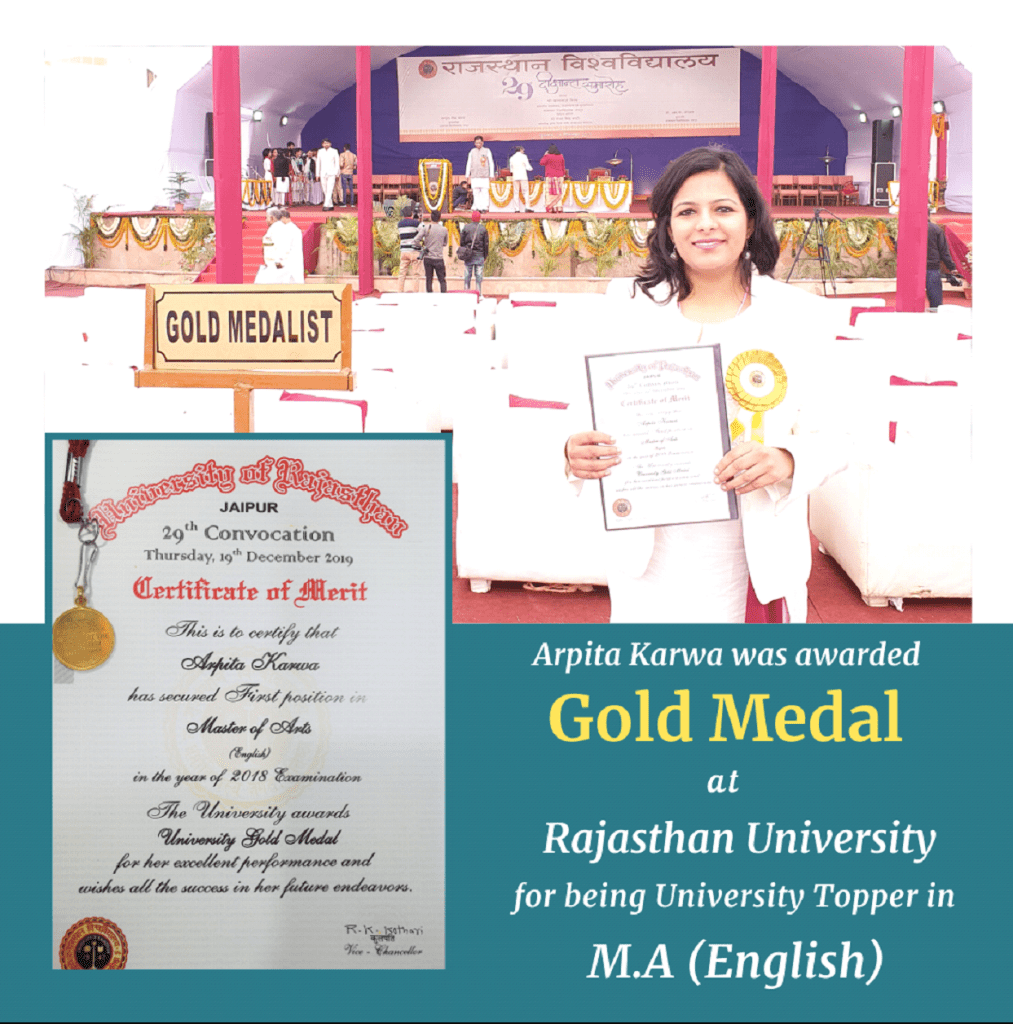JNU M.A. ENGLISH, ENTRANCE EXAM 2019
June 19, 2023 2023-12-11 18:22JNU M.A. ENGLISH, ENTRANCE EXAM 2019
JNU M.A. English, Entrance Exam 2019
JNU
M.A. ENGLISH ENTRANCE EXAM, 2019
Q.1) Match the following:
List-I
(a) Negative capability
(b) Objective correlative
(c) Imagism
(d) Esemplastic Imagination
List-II
(i) Samuel Taylor Coleridge
(ii) John Keats
(iii) Ezra Pound
(iv) T.S. Eliot
[1] a-iii, b-ii, c-i, d-iv
[2] a-ii, b-iv, c-iii, d-i
[3] a-i, b-iii, c-ii, d-iv
[4] a-iii, b-ii, c-iv, d-i
Answer: a-ii, b-iv, c-iii, d-i
Q.2) Metre Language measured usually be the foot, into line-lengths of patterned verse. Please identify such measuring given below:
(a) Quantitative (by long and short sound)
(b)Syllabic (by syllabic count).
(c) Accentual (by stress count).
(d) Accentual/syllabic (by both stress and syllabic count).
[1] Sentence a is true but “b”, “c are wrong.
[2] Sentence ‘b’, ‘c’ are wrong but ‘d’ is true
[3]All of the above are wrong
[4]All of the above are true
Answer: All of the above are true
Q.3) Iden of a University, the collected lectures dating from 1852 onwards and published in 1873 by……. .
[1] John Henry Newman
[2] Samuel Johnson
[3] James Joyce
[4] Farah Nuruddin
Answer: John Henry Newman
Q.4) A Vision by W.B. Yeats is.
[1] A play
[2] A novel in verse
[3] A book of mystical philosophy
[4] A poem
Answer: A book of mystical philosophy
Q.5) Which of the following was not published in the 1930?
[1] Kanthapura
[2] Untouchable
[3] Swami and Friends
[4] My Experiments with Truth
Answer: My Experiments with Truth
Q.6) Which of the following novels is not written in the stream of consciousness:
[1] The Sound and the Fury
[2] Mrs. Dalloway
[3] The Old Man and the Sea
[4] Ulysses
Answer: The Old Man and the Sea
Q.7) Which of the following develops into Rasa:
[1] Vibhava
[2] Sattvika-bhava
[3] Vyabhichari-bava
[4] Sthayi-bhava
Answer: Sthayi-bhava
Q.8) Match the following:
List I
(a) He is as brave as a lion
(b) Time is a thief
(c) He is as skinny as a toothpick
(d) The moon smiled at the stars
List II
(i) personification
(ii) simile
(iii) metaphor
(iv) hyperbole
Codes:
[1] a-iv, b-ii, c-iii, d-i
[2] a-ii, b-iii, c-i, d-iv
[3] a-iii, b-iv, c-ii, d-i
[4] a-ii, b-iii, c-iv, d-i
Answer: a-ii, b-iii, c-iv, d-i
Directions (Q.9 to 11):
The inarticulacy of the tragic hero, which distinguishes the main figure in Greek tragedy from all his successors, is one of the foundation stones of the theory of tragedy. “For this is the mark of the self, the seal of its greatness and the token of its weakness alike: it is silent. The tragic hero has only one language that is completely proper to him: silence. It has been so from the very beginning. The tragic devised itself the artistic form of the drama precisely so as to be able to present silence… In his silence the hero burns the bridges connecting him to God and the world, elevates himself above the realm of personality, which in speech, defines itself against others and individualizes itself, and so enters the icy loneliness of the self. The self knows nothing other than itself, its loneliness is absolute’.
Q.9) Where does the essence of the tragic lie?
[1] In the tragic hero’s not being able to be a self
[2] In the tragic hero’s not being able to be a personality
[3] In the tragic hero’s not being able to connect to the world and God in speech
[4] None of the above
Answer: In the tragic hero’s not being able to connect to the world and God in speech
Q.10) The writer here offers:
[1] A neo-classical theory of tragedy
[2] A Marxist conception of tragedy
[3] A psychoanalytic conception of tragedy
[4] None of the above
Answer: None of the above
Q.11) This passage argues that:
[1] Tragic is the experience of selfhood.
[2] Personality arises in speech-community
[3] We should think of selfhood in distinction from personality
[4] All of the above.
Answer: All of the above
[NEGATIVE MARKS] 0
[TAG] –
[DIFFICULTY] Easy
[ANSWER TIME] 1
[QUESTION TYPE] Multi_choice
[SOLUTION] –
Directions (Q.12 to 14): But more joyful the joy, the purer the sadness slumbering within it. The deeper the sadness, the more summoning the joy resting within it. Sadness and joy play into each other. The play itself which attunes the two by letting the remote be near and the rear be remote is pain. This is why both, highest joy and deepest sadness, are painful each in its way. But pain so touches the spirit of mortals that the spirit receives its gravity from pain. That gravity keeps mortals with all their wavering at rest in their being. The spirit which answers to pain, the spirit attuned by pain and to pain, is melancholy. It can depress the spirit, but it can also lose it burdensomeness and lets its “secret breath” nestle into the soul, bestow upon it the jewel which arrays it in the precious relation to the word, and with this raiment shelters it.
Q.12) The writer shows here that:
[1] Joy and sadness are identical to each other
[2] Melancholy is the attunement of the spirit and is essentially related to the poetic word
[3] Melancholy is depressive and burdensome, and the poetic word symptomatically discloses it
[4] All of the above
Answer: Melancholy is the attunement of the spirit and is essentially related to the poetic word
Q.13) The writer here offers:
[1] A psychoanalytic theory of melancholy
[2] A psychiatric-clinical analysis of depression
[3] A sociological-historical description of pain
[4] None of the above
Answer: None of the above
Q.14) Melancholy here is understood as:
[1] A psychological state of a depressive individual
[2] A spiritual-mystical union of human beings with God
[3] An existential attunement of the mortal with world
[4] None of the above
Answer: An existential attunement of the mortal with world
Directions (Q.15 to 17):
novel, the traditional novel, she goes on to say, is an attempt to understand a human fate, to understand how it is that someone, some fellow being having started at point A, and having gone through experience B and C and D, ends up a point 2. The novel is thus, like history, an exercise in construction the past. Like history too, the novel is an investigation into the power of character and the
power of circumstance. By exploring the power of the past to produce the present, the novel suggests how we may explore the potentials of the present to produce the future, That is what the novel does, or can do. That is why we have it.
Q.15) Which of the following statements is not true?
[1] History tries to give a coherent account of the past.
[2] The novel tries to understand how people become what.
[3] History examines the potential of the future.
[4] History is concerned with the influence of character and circumstance.
Answer: History examines the potential of the future.
Q.16) Which of the following words is closest in meaning to the word “constructing” as used in the passage?
[1] Fabricating
[2] Inventing
[3] Documenting
[4] Moulding
Answer: Moulding
Q.17) In the passage, C refers to:
[1] the name of a fictional character
[2] something that happened to a character
[3] the date of a historical event
[4] none of the above
Answer: something that happened to a character
Directions (Q.18 to 20):
But no sooner had he made it clear to himself and his friends that she hardly had a good feature in her face, than he began to find it was rendered uncommonly intelligent by the beautiful expression of her dark eyes. To this discovery succeeded some others equally mortifying. Though he had detected with a critical eye more than one failure of perfect symmetry in her form, he was forced to acknowledge her figure to be light and pleasing; and in spite of his asserting that her manners were not those of the fashionable world) he was caught by their easy playfulness.
Q.18) In its presentation of woman character, passage focuses on:
[1] her beautiful features
[2] her knowledge and intelligence
[3] her excellent manners
[4] her physical appearance as a sign of her inner qualities
Answer: her physical appearance as a sign of her inner qualities
Q.19) The passage describes:
[1] the appearance and manners of a woman character
[2] the author’s views on female appearance and behaviour
[3] a male character’s perceptions and throughts on a woman character
[4] none of the above
Answer: a male character’s perceptions and throughts on a woman character
Q.20) This passage is an example of:
[1] Interior monologue
[2] Dramatic monologue
[3] Omniscient narration
[4] Unreliable narration
Answer: Omniscient narration
Directions (Q.21 to 23):
“But what was there to say?
Only that there were tears. Only that Quietness and Emptiness fitted together like stacked spoons. Only that there was a snuffling in the hollows at the base of a lovely throat. Only that a hard honey colored shoulder had a semicircle of teeth marks on it. Only that they held each other close, long after it was over. Only that what they shared that night was not happiness, but hideous grief.
Only that once again they broke the Love Laws. That lay down who should be loved. And how. And how much”.
Q.21) The last few lines in this passage imply that:
[1] all societies must have laws about who to love and how much
[2] everyone should obey the laws set down about love
[3] it is ironical that there should be laws about who should be loved, how, and how much
[4] if anyone breaks the Love Laws, they will always suffer hideous grief.
Answer: if anyone breaks the Love Laws, they will always suffer hideous grief
Q.22) The question that the above quotation begins with is:
[1] declamatory
[2] rhetorical
[3] melodramatic
[4] all of the above
Answer: rhetorical
Q.23) The two figures of speech in the sentence “Only that Quietness and Emptiness fitted together like stacked spoons” are:
[1] personification and simile
[2] metaphor and simile
[3] hyperbole and alliteration
[4] oxymoron and simile
Answer: personification and simile
Directions (Q.24 to 26):
Some village Hampden, that with dauntless breast. The little Tyrant of his fields withstood;
Some mute inglorious Milton here may rest, Some Cromwell guiltless of his country’s blood.
Th’ applause of list’ning senates to command, The threats of pain and ruin to despise,
To scatter plenty o’er a smiling land, And read their hist’ry in a nation’s eyes,
Their lot forbade: nor circumscribed alone There growing virtues,
but their crimes confin’d; Forbade to wade through slaughter to a throne,
And shut the gates of mercy on mankind,
The struggling pangs of conscious truth to hide, To quench the blushes of ingenuous shame,
Or heap the shrine of Luxury and Pride With incense kindled at the Muse’s flame.
Q.24) Lines 5-8 are best described as:
[1] the achievements of “their hist’ry” most valued in the “nation’s eyes” (line 8)
[2] a list of potential accomplishments that “Their lost forbade” (line 9)
[3] positive proof of “Their growing virtues” (line 10)
[4] belated attempts to atone for “their crimes” (line 10)
Answer: a list of potential accomplishments that “Their lost forbade” (line 9)
Q.25) “Hampden” (line 1). “Milton” (line 3), and “Cromwell” (line 4) functions as:
[1] proper nouns used generically
[2] compound subjects of an independent clause
[3] place references that mark historic battle sites
[4] the actual names of the individuals two “here may rest”
Answer: proper nouns used generically
Q.26) In lines 9.10, “nor circumscribed…. Confin’d” is best interpreted to mean that:
[1] circumstances determine whether we regard a given activity as good or evil
[2] virtue consists of acting on good impulses and suppressing evil ones
[3] circumstances prevented those described from doing deeds of greater evil as well as deeds ofgreater good
[4] the chief virtue of those described was limit the evil influence of others.
Answer: circumstances prevented those described from doing deeds of greater evil as well as deeds ofgreater good
Directions (Q. 27 to 30):
My ‘place of clear water,
the first hill in the world
where springs washed into the shiny grass
and darkened cobbles in the bed of the lane.
Anahorish, soft gradient of consonant, vowel-meadow,
after-image of lamps swung through the yards on winter evenings.
With pails and barrows
Q.27) The speaker of the passage describes an experience of:
[1] childhood
[2] middle-age
[3] old age
[4] adolescence
Answer: childhood
Q.28) The poem describes an experience of:
[1] a countryside
[2] a city
[3] a country road
[4] a small town
Answer: a country road
Q.29) The poem achieves its meaning through:
[1] Metaphor and metonymy
[2] Allegory, sound and image
[3] Voice, sound and image
[4] Rhythm, synecdoche and paradox
Answer: Voice, sound and image
Q.30) The title of the passage refers to which of the following?
[1] springs
[2] a place
[3] cobbles
[4] consonants
Answer: a place
Directions (Q.31 to 33):
In one of his chapters titled “Narayan Hemchandra” in his autobiography, M.K. Gandhi describes his meeting in England with a queer man who were strange clothes and had an amazing disregard for the English language. In the process of teaching him English, Gandhi noticed that Narayan Hemchandra was “innocent of grammar”. ‘Horse’ was a verb with him and ‘run’ a noun. I remember many such funny instances. But he was not to be baffled by his ignorance. My little knowledge of grammar could make no impression on him. Unperturbed by his own ignorance, he challenged Gandhi, “…. do you know Bengali? I know it. I have travelled in Bengal. It is I who has given Devendranath Tagore’s works to the Gujarati speaking world.”
Q.31) The quotations in the passage are from:
[1] The Story of My Experiments with Truth
[2] A book on Gandhi by Rita Kothari
[3] A chapter on Narayan Hemchandra by Rita Kothari
[4] M.K. Gandhi’s book on Bengali and Gujarati
Answer: The Story of My Experiments with Truth
Q.32) Which of the following would describe what this passage illustrates?
[1] Postmoderinism and its disdain for purity in language
[2] The inability of Indians to speak English properly
[3] M. K. Gandhi’s respect for the English language
[4] The assertion of the importance of native languages
Answer: The assertion of the importance of native languages
Q.33) Which of the sequences given after the lists below matches items from the two lists correctly.
List I
(a) ‘Cunning of reason’
(b) ‘Make it New’
(c) ‘The Whole is the Untrue’
(d) ‘The banality of evil’
List II
(i) Pound
(ii) Arendt
(iii) Adorno
(iv) Hegel
Codes:
[1] a-iv, c-ii, d-i
[2] a-iii, b-i, d-ii
[3] a-ii, b-i, c-iv
[4] a-iv, c-iii d-ii
Answer: a-iv, c-iii d-ii
















